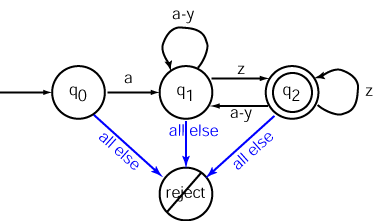Answer:

(My symbol for the "reject" state is not official.)

(My symbol for the "reject" state is not official.)
You can translate a deterministic finite state automaton into a Java method almost mechanically. Experienced programmers use this trick frequently. When you know the trick, you will see that many problems involve an automaton. Writing the program will be routine.
The essential idea:
state.if or an else if statement.
Java does not actually have an
else if statement.
What is called an else if statement
is a method of indenting ordinary
if and else statements
so that each of many options is
at the same level of indenting.
This is extremely useful.
The following fragment shows
how this is done.
Refer to the automaton as you
study it.
public boolean recognize(String str)
{
final int reject = 3;
int state = 0;
char current;
while ( ... )
{
current = next character in the string;
// State 0
if ( state==0 && current=='a' )
state = 1;
// State 1
else if ( state==1 && current >= 'a' && current <= 'y')
state = 1;
else if ( state==1 && current == 'z')
state = 2;
. . . . . .
else
state = reject ;
}
}
If the current character is not accepted by the current state, a transition is made to the reject state. How is this implemented?